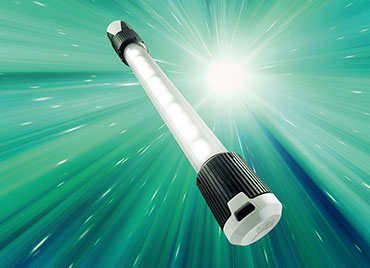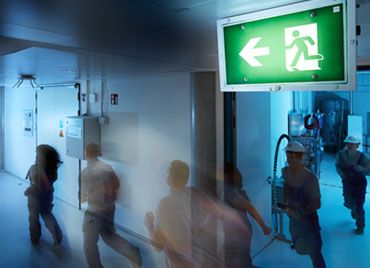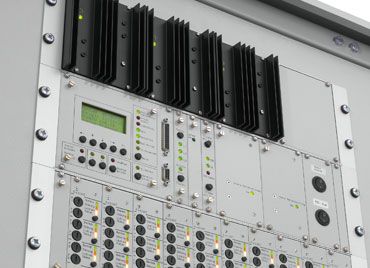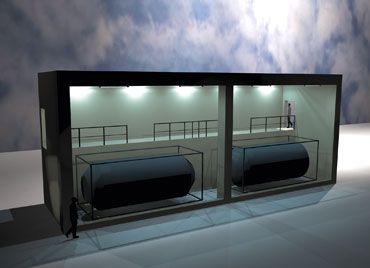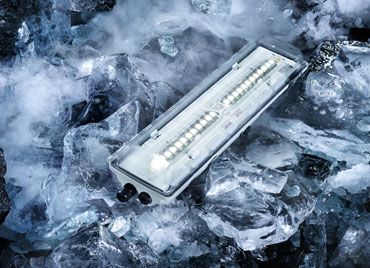Efficient, durable and robust
The paradigm change in lighting technology is in full swing – the future, including for industry, is in LED technology since no other lighting technology utilises the electrical energy input as efficiently and has a long service life.
Some people are delaying the changeover, but there is undoubtedly no better time than now.
Regardless of whether you want to save energy, reduce maintenance costs or benefit from a long-life luminaire – the changeover to LED technology is the way to achieve it.
The service life of LEDs alone – up to 100,000 hours – exceeds the values for conventional light sources by many times over. This increases the maintenance-free time exponentially. Particularly when combined with maintenance-free lighting designs, the operating and maintenance costs are negligible minimum.
High-performance diodes provide excellent luminous efficacy with up to 180 lm/W, the LED is nearly ten times as efficient as a normal halogen lamp. LED luminaires are also experts in saving energy. This means that the slightly higher procurement costs will be amortised after only a few years.
At the same time, reduced CO2 emissions will contribute to climate change protection and in addition, does not contain any mercury, which means that LEDs can be described as being environmentally friendly.
LED luminaires improve safety as they do not leave anyone abruptly standing in the dark. They lose their luminescence gradually and hence don't fail completely all of a sudden.
LED technology is ideal for use in extreme temperatures in particular because it boasts a high vibration resistance, which means that it is especially well suited to use in harsh industrial environments. It is also characterised by a low heat build-up and can therefore still be used at temperatures from -60 °C to 70 °C. In addition, luminous intensity can be controlled depending on the ambient brightness.
In an interview with Rico Schulz, Product Manager Lighting Technology, you read more about smart light across entire hazardous areas.
LED lighting compared to conventional lighting technology
LED luminaires have numerous benefits over conventional luminaires. We have compared them for you in the table below.
| LED | Light bulbs | Glow discharge lamps | Fluorescent lighting | |
|---|---|---|---|---|
| Lighting efficiency | 35% of the energy is converted into light | 5% of the energy is converted into light | 15- 20% is converted into light | 15- 20% is converted into light |
| Service life | 100,000 h | 2,000 h | 25,000 h | 16,000 - 50.000 h |
| Environmental compatibility | No mercury, reduced CO2 emmissions | Very good | Contains mercury, pollutes the environment | Contains mercury, pollutes the environment |
| Starting behaviour | Full light output after a few ms | ~ms | up to 300 s | up to 120 s |
| Ambient temperatures | -60 °C up to +70 °C | -60 °C up to +60 °C | -60 °C up to +60 °C | -30 °C up to +60 °C |
You can see that LED technology provides you with both tangible and intangible benefits. So do not delay any further and switch to LED – become part of the future.
Here you can find a list of frequently asked questions relating to LEDs
1. What are the benefits of LED compared to conventional luminaire lighting?
- Longer service life. This increases the maintenance-free operating period.
- High-performance diodes provide excellent luminous efficacy.
- LEDs are incredibly energy efficient.
- Operating and maintenance costs are reduced to a minimum.
- Lower CO2 emissions – this means that using LED lamps helps reduce climate change.
- Ideal for use in extreme temperatures.
- LEDs are set apart from other lights due to their high vibration resistance. This makes them especially suitable for use in harsh industrial environments.
- LED lamps improve safety, because they lose their luminosity gradually and do not fail suddenly.
- The luminous intensity can be adjusted in accordance to the varying ambient.
2. What are the disadvantages of LED?
LEDs are initially expensive in terms of procurement costs, but ultimately the cost benefits of using modern LED technology far outstrip this in the long-term. These benefits can be easily established via our TCO-/ ROI calculator.
3. Should we wait a little longer before using LED?
No. LED technology is the most cost-effective and the most up-to-date lighting technology in the market. When you switch as early as possible, the long operating life ensures great cost benefits. Quick decisions will save you maintenance costs as well.
4. Do LED luminaires cause damage to the eyes?
No. All LED luminaires are subject to the EU Directive 2006/25/EC and are tested in accordance with EN 62471. This inspection must be confirmed with the EU declaration of conformity. When using LED luminaires which meet these criteria, there is no riskof eye damage.
5. What effects does LED lighting have on light emissions and does this harm the environment?
R. STAHL's luminaires are developed in line with the guidelines issued by the IDA (International Dark Sky Association). This means that their radiation angles are configured such that no light is emitted towards the upper hemisphere, thus preventing light pollution. In line with EN 12464, the light is only emitted in the directions in which it is needed in order to fulfil the user's lighting requirements.
R. STAHL also produces luminaires that block shortwave radiation (specifically UV and blue light), as this kind of radiation has a tendency to attract insects. Ongoing investigations into the possible harmful effects of light on animals are a major focus at
R. STAHL, and the findings of these investigations are incorporated into the design of our luminaires.




